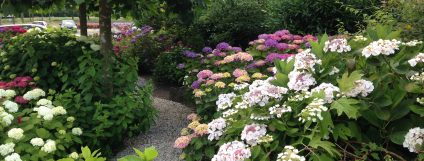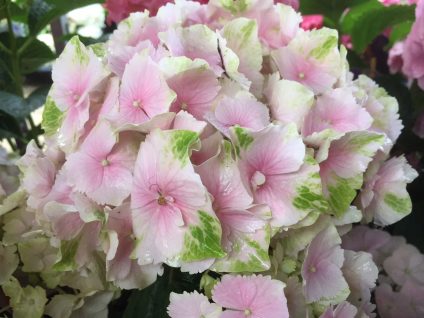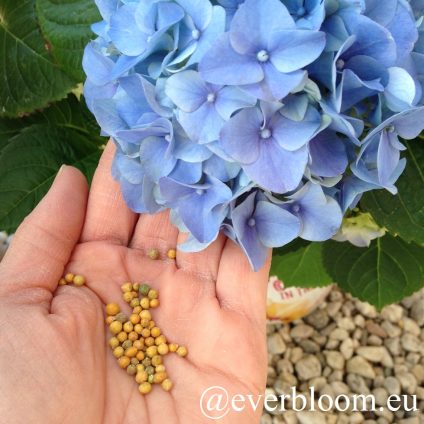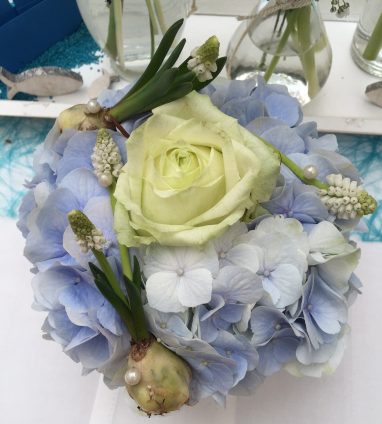To get the most pleasure out of your Everbloom® hydrangea, we would like to give you a number of tips for the best cultivation.
Site

Your Everbloom hydrangea can take a few hours of direct sun during the day, morning or afternoon sun at best. Strong insolation, anyhow – and the hot noon sun especially – is too much. In Central Europe Everbloom-hydrangeas can overwinter outside, in flower bed and pot. Temperatures down to -15 degrees Celsius aren’t a problem. Potted hydrangeas like sheltered sites, though. A “winter coat” around the pot does a good deed, too; for example jute or fleece. Important: Rain or irrigation water has to be able to drain well. Stagnant moisture leads to root rot. On the other hand, the root bale must not dry out completely, either. In doubt water the hydrangea on frost-free winter days.
Planting
Before planting your Everbloom, soak the bale in a bucket of water. The planting hole should be around 20 cm larger and 10 cm deeper than the original pot size. Up to the right planting height fill the hole with new hydrangea or azalea soil to achieve the right pH value. Now remove the old pot and place the bale into the planting hole. Fill up the hole 2/3rds with special soil, the rest with garden soil. Finish by watering again. During the first weeks, water regularly, but avoid stagnant moisture. Keep a planting distance of at least 75 cm to other hydrangeas, the shrubs quickly can gain a diameter of 1.5 meters.
Repotting
 When repotting an Everbloom hydrangea always use a larger pot, so that you can add fresh soil. Special soil for hydrangeas or azalea is best, because it has the pH value needed. The best time to repot your Everbloom is April or May, when growth starts again and new roots can sprout. Watch out: water diligently after repotting, but avoid stagnant moisture at all costs.
When repotting an Everbloom hydrangea always use a larger pot, so that you can add fresh soil. Special soil for hydrangeas or azalea is best, because it has the pH value needed. The best time to repot your Everbloom is April or May, when growth starts again and new roots can sprout. Watch out: water diligently after repotting, but avoid stagnant moisture at all costs.
Cutting
Coming to the question of how to cut, your Everbloom now shows all her potential. Compared to other hydrangeas, you can’t do much wrong here. Because Everbloom hydrangeas blossom on their new sprouts as well as on their old ones. This is quite unique. Therefore, you can cut out withered blossoms whenever you want. Cutting them off immediately and directly under the umbel will enhance the chance that new side buds will form that same year, for another bloom in late summer. If you want to trim the plant for size or form, the best time is between the end of February and the beginning of March.
Watering
Hydrangeas are very thirsty, especially in warm weather. Regular watering will be rewarded with a voluminous bloom. In case the leaves still hang down once in a while, just add a good amount of water at once, and they will stand up again without taking too much harm. Water early in the day or in the evening hours at best. If possible, do not rinse the leaves or blossoms, but give the water directly onto the bale.
Fertilizing
 Fertilizing in March or April and again when the hydrangea is in full bloom gives your Everbloom an extra kick for a voluptuous green and bloom. Hydrangea fertilizer is available in specialist shops. Stick to the instructions of your chosen product.
Fertilizing in March or April and again when the hydrangea is in full bloom gives your Everbloom an extra kick for a voluptuous green and bloom. Hydrangea fertilizer is available in specialist shops. Stick to the instructions of your chosen product.
Pink or Blue?
Did you know that you can change the colour of red, pink and blue hydrangeas yourself? The colour of the blossoms is dependent on the pH value and aluminum content of the soil. To change blue into pink add chalk to the soil, That heightens the pH value. To turn pink into blue or red into lilac, add a special hydrangea-blue-powder (available e.g. in garden centers or online-shops). To get a bright blue or deep lilac you need a pH value of 4 to 4.5. At a value of 4.5 to 5 you have mixed colours and with a pH value of 5 to 5.5 the blossoms will become pink or red.
Cutflowers
 Everbloom hydrangeas are very well suitable as cutflowers for vases. From all known varieties that bloom at new sprouts, Everbloom has the biggest single blooms. That makes an impressing view on your dining table! The stalks of Everbloom are strong and last long. It is recommended to cut the stalks obliquely and to exchange the water regularly to keep the blossoms fresh for a long time.
Everbloom hydrangeas are very well suitable as cutflowers for vases. From all known varieties that bloom at new sprouts, Everbloom has the biggest single blooms. That makes an impressing view on your dining table! The stalks of Everbloom are strong and last long. It is recommended to cut the stalks obliquely and to exchange the water regularly to keep the blossoms fresh for a long time.
Drying blossoms
When summer ends it is time to fetch the most beautiful blooms of your Everbloom inside to decorate the house. Dried blossoms last during the complete wintertime. The flowers “green” after the actual blossoming time. That means, they become harder, dryer, and change their colour, often into some shade of green or red. Now you can cut and dry them. Here are some good methods for drying:
• Hang up the blossoms head down in a dark, warm place and wait. So they keep their shape and colour best.
• The florists’ tip for the impatient: place the cut flowers into well-absorbing cat litter. Or on a sheet of newspaper.
